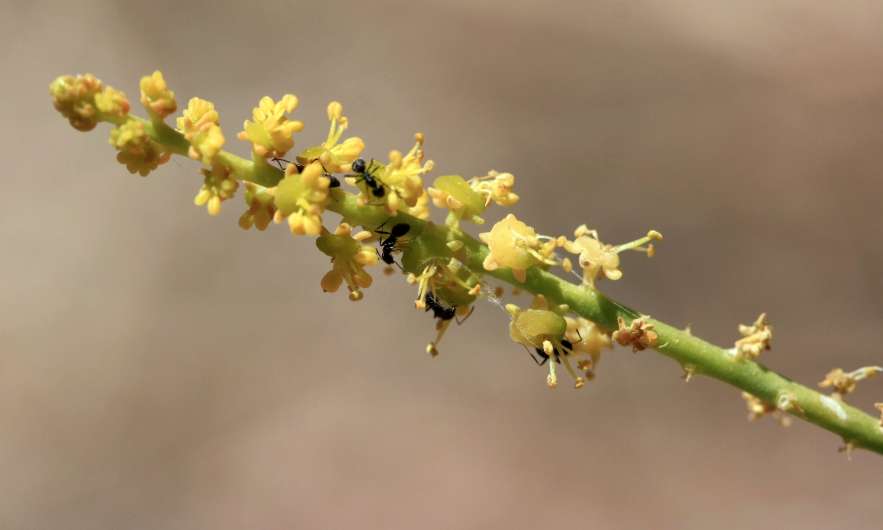


The distinctive yellow flower stalks and the pearl-like fruit of this desert shrub make it easy to recognize and remember. The pearl plant (Ochradenus baccatus) is quite common in the region and are spotted often on my wanders in the wadis near Dahab. In the springtime, they are buzzing with flying insects – bees, wasps, flies, hover flies, beetles, and more I’m sure. This shrub has been reported as one of the most important food sources for many animal species.

There’s one species in particular that the plant has a special relationship with – the Egyptian spiny mouse (Acomys cahirinus). The fruit – a fleshy, juicy berry – is attractive to desert animals. But when an enzyme in the flesh of the berries combines with what’s inside the seed, it creates a toxic “mustard oil bomb”, deterring most animals from munching on this fruit (and destroying the seeds in the process). The spiny mouse has adapted to this, however. They will collect fruits and bring them to a different, rocky area, one that is safer for them. There, the mice chew and eat the flesh, careful not to bite the seed which they then spit out, avoiding any nastiness and helping to disperse the plant’s seeds. One study suggests these safer places the mice choose are actually “the best places for young O. baccatus plants to germinate, grow and survive.” How’s that for some symbiotic behavior!



The Bedouin of Sinai have also found benefits of the pearl plant, using it in traditional medicine to cure joint pain. A bowl of water in which the leaves have been boiled is placed in a hole in the ground above which a makeshift tent is constructed. The patient then lies beneath its cover for 24 hours. Pearl plant is also used to cure aches and pains in a camel’s body except instead of boiling the leaves, the plant is placed on embers in a hole. In Saudi Arabia, the plant is used to lower blood cholesterol and to counteract malaria.

Recently, a friend and fellow plant-lover asked me if this species had separate male and female plants as she had noticed that some plants were full of berries, while others only had a few. In dioecious plants, only the plants that grow female flowers produce fruit. Date palms are a good example. It turns out, though, that the pearl plant is gynodioecious, meaning that some plants have only female flowers and some plants are bisexual, having both male and female flowers. This explains the phenomenon my friend noticed – two plants, side by side, both in full bloom but only one seeming to fruit fully.

I’ve always liked this plant’s Latin name, Ochradenus baccatus. Ochradenus comes from the Greek for “pale yellow” or “yellow ochre”, and baccatus means “adorned with berries”. It is also known as taily weed and shrubby or sweet mignonette in English and is called gurdhi by the Bedouin in South Sinai.
References:
Bailey, C., & Danin, A. (1981). Bedouin plant utilization in the Sinai and the Negev. Economic Botany, 35(2), 145–162.
K.C. Burns. Seed Dispersal: The Blind Bomb Maker. Current Biology, Volume 22 (Issue 13), 2012, Pages R535-R537. https://doi.org/10.1016/j.cub.2012.05.014.
